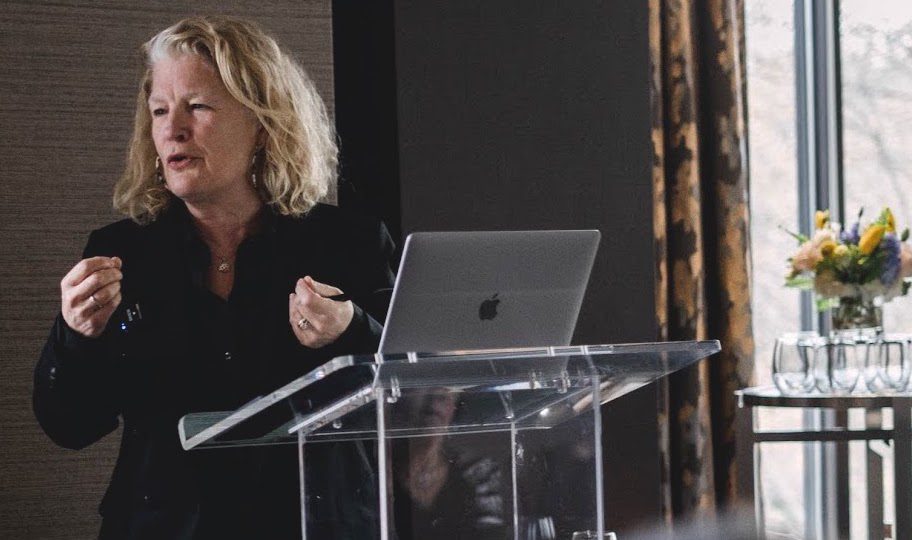Cultural Power Breakfast: GWU’s Corcoran: ‘A Very Different School’
By • March 27, 2023 One Comment 3212

Of the storied institution that was the Corcoran Gallery of Art and College of Art and Design, Dr. Lauren Onkey, director since 2021 of George Washington University’s Corcoran School of the Arts and Design, stated: “I don’t try to compete with that past.”
A scholar of literature and popular culture who also held senior positions at NPR and the Rock and Roll Hall of Fame and Museum, Onkey was the featured speaker at The Georgetowner’s March 23 Cultural Power Breakfast; the series now meets at the Four Seasons Hotel Washington, DC.
In 2014, the Corcoran’s assets and operations were turned over to the National Gallery of Art, which acquired much of the collection (some went to other museums), and George Washington University, which took ownership of the 1897 landmark on 17th Street NW, designed by Ernest Flagg, and merged the college with its own school of the arts.
While calling it “important to acknowledge the loss,” Onkey emphasized that “what GW did … was create a very different school.” About 600 students, undergraduate and graduate, are currently enrolled in seven different Corcoran programs, not only in the Flagg Building but on the main campus. “I need to think equitably across all these programs,” she said.
The Corcoran School now encompasses studio art, art history, museum studies, interior architecture, music, theater and dance. A fundamental question for Onkey: “How do we incentivize and excite people about interdisciplinary work?”
Crediting her predecessors — Sanjit Sethi, who left in 2019 to become president of the Minneapolis College of Art and Design, and Kym Rice, who served as interim director — for managing the transition, Onkey came on board after a year of pandemic restrictions. The faculty “did heroic work” during the period when classes were virtual and studios and practice rooms were closed, she said. She invited attendees to imagine “dancing in your basement [or] painting in the garage of your parents.” Some painting and photography students had “never seen their work on the wall” until last spring’s NEXT exhibition in the Flagg Building.
Due to its marble stateliness, “making the Flagg Building feel like home is an ongoing challenge.” Onkey said she’s glad to see a new student piece in the atrium when she comes to work in the morning (whether it appeals to her or not). A challenge within the challenge is the Salon Doré, the elaborately decorated, 18th-century Parisian drawing room on the first floor. As a way to “animate” the salon, Onkey gave the go-ahead for a two-night musical experience; among the improvised lyrics was the following sentiment: Why is it sometimes we take better care of a room than of people?
Though the call-out caught her off guard, Onkey believes “our institutions have to be places of self-critique” and “the ways that students challenge us and make us uncomfortable is really important.” The present college cohort is impatient for change, she cautioned, dismissive of talk of a “process” or a “task force.”
Onkey shared several insights on how to diversify organizations and audiences. At NPR Music, for example, the live-performances series she oversaw, Tiny Desk Concerts, “exploded” when hip-hop selections were given more prominence, racking up two billion YouTube views and drawing NPR’s youngest and most diverse audience. Her advice: Diversify the decision-makers and consider what your desired audience wants and where they want it. In addition, “really recognizing that our audience has expertise” — as at the Rock and Roll Museum — is key to engagement. YouTube, she noted, is “dialogue-capable.”
Also on the topic of diversity, Onkey said that while the school needs to be open about Georgetowner William Wilson Corcoran’s connections to and sympathy for the Confederacy, the gallery’s historical promotion of Black artists likewise merits attention.
This year’s NEXT event will take place from April 20 to May 20 with “more of a festival format,” presenting 40 exhibitions along with performances, lectures and panels in multiple locations. Visual art by graduating students — Onkey: “They’re starting to feel pain right now” — will go on view in the Flagg Building on May 4.
Will traditional museum exhibitions ever return? Having met with National Gallery of Art Director Kaywin Feldman regarding the “commitments made in 2014,” Onkey said that displays of art will become possible once climate-control work in the second-floor gallery spaces is complete.


Dear Editor, Please fact check: “In 2014, the Corcoran’s assets and operations were turned over to the National Gallery of Art…” What “operations”? The NGA was supposed to install art works in the upper five galleries of the Corcoran’s 17th Street building. Plus, a “Legacy Gallery” of key works from the Corcoran’s collection was also to be created. Neither happened. It’s going on nine years. Why? GWU was given $46 million cash, the tuition income from original Corcoran students, in addition to the $200 million building that had air conditioning installed by former director Peter C. Marzio. GW is responsible for the climate control. What’s the hold up?
Fact about GW’s “takeover” of the school. One could hardly call it a merger. “George Washington University dismissed about 150 staff and adjunct faculty immediately after the merger, while remaining professors were placed on one-year contracts. The Corcoran School’s first semester as part of GW was also unpleasant for some of its students, who said at the time the university did not inform them of certain campus fees and administrative changes.” Washingtonian Magazine. Excerpt from article by Benjamin Freed, May 16, 2022.